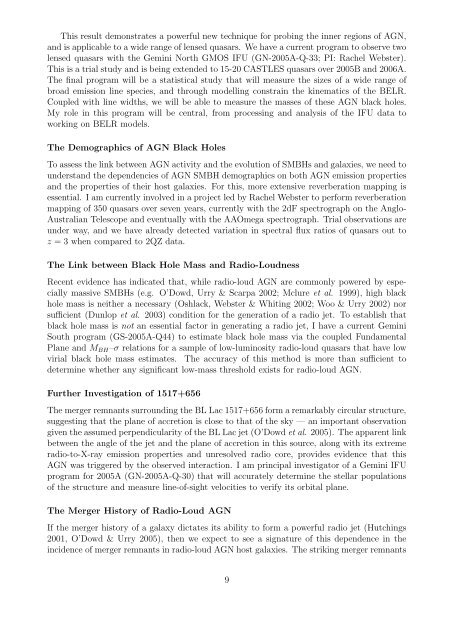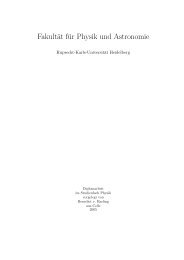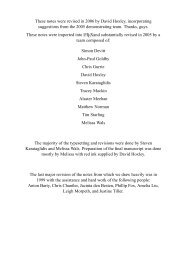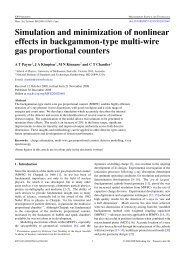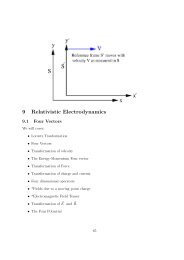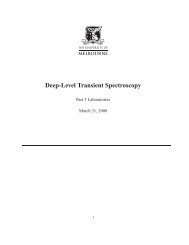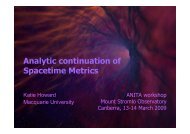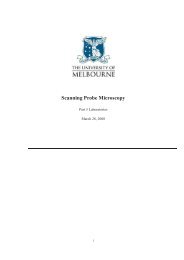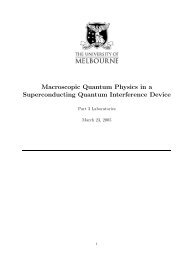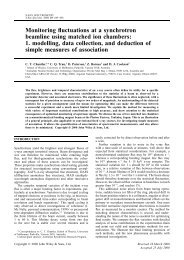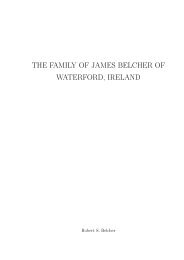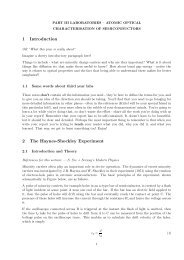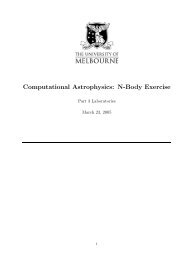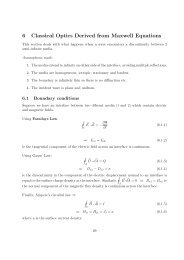Matthew John O'Dowd - School of Physics - University of Melbourne
Matthew John O'Dowd - School of Physics - University of Melbourne
Matthew John O'Dowd - School of Physics - University of Melbourne
You also want an ePaper? Increase the reach of your titles
YUMPU automatically turns print PDFs into web optimized ePapers that Google loves.
This result demonstrates a powerful new technique for probing the inner regions <strong>of</strong> AGN,<br />
and is applicable to a wide range <strong>of</strong> lensed quasars. We have a current program to observe two<br />
lensed quasars with the Gemini North GMOS IFU (GN-2005A-Q-33; PI: Rachel Webster).<br />
This is a trial study and is being extended to 15-20 CASTLES quasars over 2005B and 2006A.<br />
The final program will be a statistical study that will measure the sizes <strong>of</strong> a wide range <strong>of</strong><br />
broad emission line species, and through modelling constrain the kinematics <strong>of</strong> the BELR.<br />
Coupled with line widths, we will be able to measure the masses <strong>of</strong> these AGN black holes.<br />
My role in this program will be central, from processing and analysis <strong>of</strong> the IFU data to<br />
working on BELR models.<br />
The Demographics <strong>of</strong> AGN Black Holes<br />
To assess the link between AGN activity and the evolution <strong>of</strong> SMBHs and galaxies, we need to<br />
understand the dependencies <strong>of</strong> AGN SMBH demographics on both AGN emission properties<br />
and the properties <strong>of</strong> their host galaxies. For this, more extensive reverberation mapping is<br />
essential. I am currently involved in a project led by Rachel Webster to perform reverberation<br />
mapping <strong>of</strong> 350 quasars over seven years, currently with the 2dF spectrograph on the Anglo-<br />
Australian Telescope and eventually with the AAOmega spectrograph. Trial observations are<br />
under way, and we have already detected variation in spectral flux ratios <strong>of</strong> quasars out to<br />
z = 3 when compared to 2QZ data.<br />
The Link between Black Hole Mass and Radio-Loudness<br />
Recent evidence has indicated that, while radio-loud AGN are commonly powered by especially<br />
massive SMBHs (e.g. O’Dowd, Urry & Scarpa 2002; Mclure et al. 1999), high black<br />
hole mass is neither a necessary (Oshlack, Webster & Whiting 2002; Woo & Urry 2002) nor<br />
sufficient (Dunlop et al. 2003) condition for the generation <strong>of</strong> a radio jet. To establish that<br />
black hole mass is not an essential factor in generating a radio jet, I have a current Gemini<br />
South program (GS-2005A-Q44) to estimate black hole mass via the coupled Fundamental<br />
Plane and M BH –σ relations for a sample <strong>of</strong> low-luminosity radio-loud quasars that have low<br />
virial black hole mass estimates. The accuracy <strong>of</strong> this method is more than sufficient to<br />
determine whether any significant low-mass threshold exists for radio-loud AGN.<br />
Further Investigation <strong>of</strong> 1517+656<br />
The merger remnants surrounding the BL Lac 1517+656 form a remarkably circular structure,<br />
suggesting that the plane <strong>of</strong> accretion is close to that <strong>of</strong> the sky — an important observation<br />
given the assumed perpendicularity <strong>of</strong> the BL Lac jet (O’Dowd et al. 2005). The apparent link<br />
between the angle <strong>of</strong> the jet and the plane <strong>of</strong> accretion in this source, along with its extreme<br />
radio-to-X-ray emission properties and unresolved radio core, provides evidence that this<br />
AGN was triggered by the observed interaction. I am principal investigator <strong>of</strong> a Gemini IFU<br />
program for 2005A (GN-2005A-Q-30) that will accurately determine the stellar populations<br />
<strong>of</strong> the structure and measure line-<strong>of</strong>-sight velocities to verify its orbital plane.<br />
The Merger History <strong>of</strong> Radio-Loud AGN<br />
If the merger history <strong>of</strong> a galaxy dictates its ability to form a powerful radio jet (Hutchings<br />
2001, O’Dowd & Urry 2005), then we expect to see a signature <strong>of</strong> this dependence in the<br />
incidence <strong>of</strong> merger remnants in radio-loud AGN host galaxies. The striking merger remnants<br />
9


